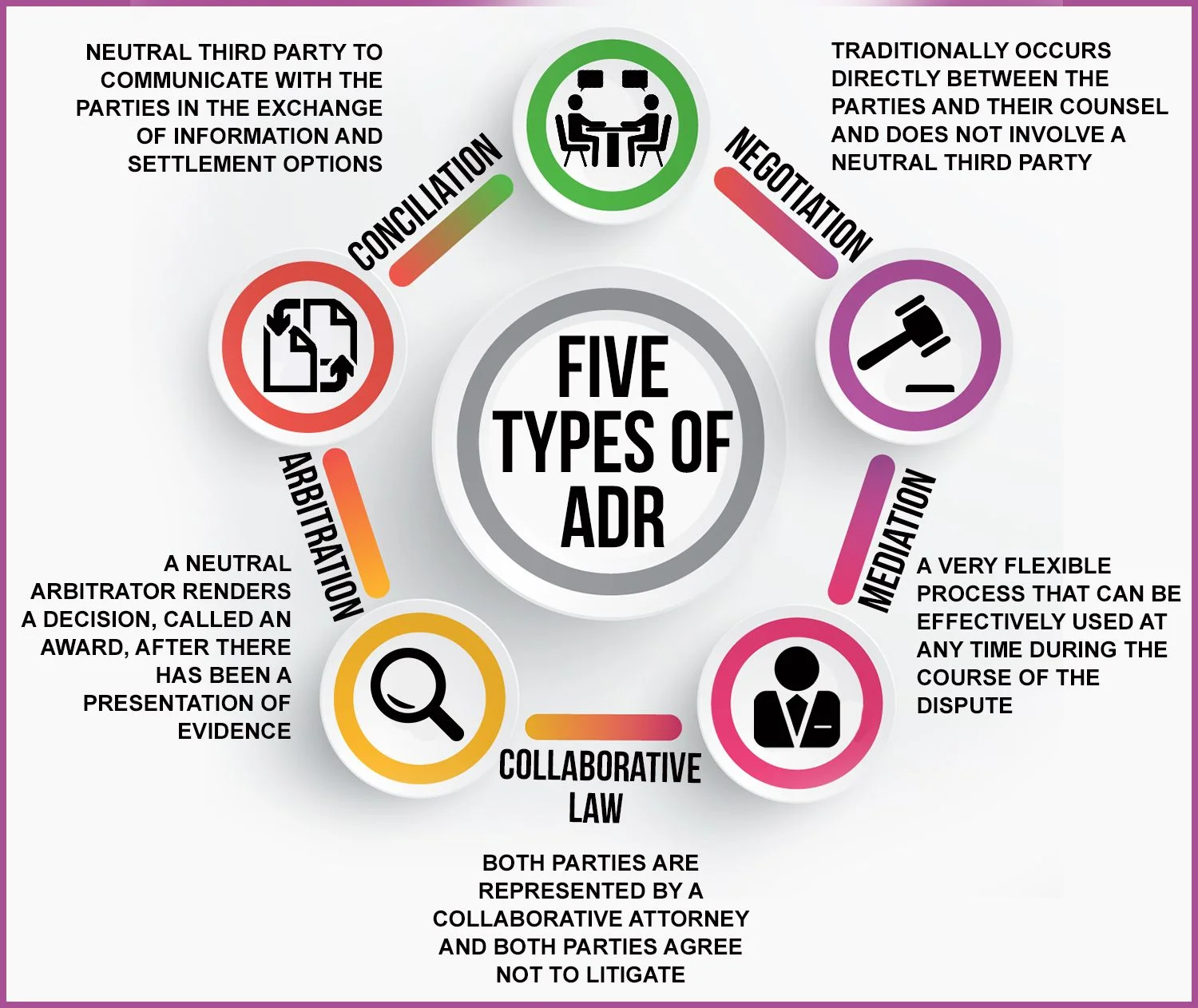Alternative Dispute Resolution (ADR) in India | 08 Oct 2025
Why in News?
The Law and Justice Minister emphasized the need for global cooperation to strengthen Alternative Dispute Resolution (ADR) mechanisms, referencing the Panch Parmeshwar doctrine, which advocates for collective consensus in dispute resolution.
What is Alternative Dispute Resolution (ADR) Mechanism?
About:
- ADR refers to processes for resolving disputes outside courts, offering a faster, cheaper, and cooperative alternative where parties work together for the best resolution.
Constitutional and Legal Basis:
- The constitutional basis of ADR in India is Article 39A, ensuring equal justice and free legal aid.
- ADR methods like arbitration, conciliation, mediation, and Lok Adalat are recognised under Section 89 of the Code of Civil Procedure, 1908.
- The Arbitration and Conciliation Act, 1996 (amended 2021) allows binding resolution of civil and compoundable offences and establishes the Indian Arbitration Council, with a 180-day limit for dispute resolution to ensure faster justice.
Models of ADR:
- Arbitration: Neutral third party makes a binding decision, commonly in commercial disputes, offering a formal yet flexible alternative.
- Mediation: Impartial mediator helps parties reach a non-binding, cooperative solution, preserving relationships.
- Conciliation: Like mediation but with more intervention, suggesting solutions for family, business, and employment disputes.
- Negotiation: Informal, consensual process where parties directly agree, giving maximum control over the outcome.
- Lok Adalat: People’s Courts in India for extrajudicial, amicable resolution of family, labor, and minor civil cases.
- Lok Adalats, governed by the Legal Services Authorities Act, 1987, were first held in Gujarat in 1999.
- Their decisions are final with no appeal, as they resolve disputes before formal litigation, though their powers are not absolute.
Need for ADR:
- Reducing Judicial Backlog: India has 4.57 crore pending cases, many delayed over 10 years, causing injustice. Strengthening ADR offers a faster alternative to traditional litigation.
- Accessible and Inclusive Justice: ADR provides a cost-effective, inclusive, pre-litigation mechanism, allowing parties to resolve disputes on their terms and in a familiar language.
- Addressing State-wise Disparities: The India Justice Report 2025 shows high pending cases and disparities in infrastructure and judges in states like Andhra Pradesh, Uttar Pradesh, and Bihar, highlighting the need for robust ADR systems.
- Enhancing Justice Delivery: With 33% High Court and 21% district court vacancies, ADR mechanisms are vital for timely and effective access to justice.
- Global Alignment: ADR is in alignment with global standards, such as the United Nations Commission on International Trade Law (UNCITRAL) Model Law, which ensures its compatibility with international legal frameworks.
- Foreign investors often favor ADR due to its neutrality, cost-effectiveness, and efficiency, making it a key component in enhancing India’s engagement with the global economy.
What are the Key Challenges Facing ADR in India & Suggest Measures to Address Them?
|
Challenges (Mnemonic: DELAY) |
Measures (Mnemonic: CURES) |
|
D - Deficit of Infrastructure: Inadequate institutional support, underutilization of legal provisions, and a lack of robust court-annexed ADR centres hinder accessibility. |
C - Create Infrastructure: Establishing a nationwide network of accredited ADR centres and leveraging the Mediation Act, 2023, for structural support. |
|
E - Enforcement & Trust Deficit: Perceptions of bias, power imbalances, and procedural delays in enforcement undermine trust in ADR outcomes. |
U - Upskill & Educate: Launching public awareness campaigns and integrating ADR into legal education to make it a preferred first resort. |
|
L - Legal Culture & Mindset: A deep-seated litigation mindset and low awareness about ADR's benefits among the public and legal professionals. |
R - Regulate & Reinforce: Strengthening the regulatory framework for neutrals and ensuring time-bound enforcement of awards to build trust. |
|
A - Absence of Quality Neutrals: A shortage of trained arbitrators and mediators, and a lack of uniform accreditation standards. |
E - Elevate Standards: Empowering institutions to standardize training and enforce a strict code of conduct for ADR practitioners. |
|
Y - Yielding to Procedural Complexity: Arbitration becoming as protracted as litigation (arbitration fatigue) and mediation being used for tactical delays. |
S - Streamline Processes: Promoting fast-track mechanisms and imposing cost penalties for bad-faith participation to ensure genuine resolution. |
|
Drishti Mains Question: Discuss the significance of Alternative Dispute Resolution (ADR) in reducing judicial backlog in India. |
Frequently Asked Questions (FAQs)
1. What is Alternative Dispute Resolution (ADR)?
ADR is a non-adversarial mechanism for resolving disputes outside courts, offering a faster, cost-effective, and cooperative resolution.
2. What is the constitutional basis of ADR in India?
ADR is enshrined in Article 39A, ensuring equal justice and free legal aid, and recognised under Section 89 of the CPC, 1908.
3. Which ADR methods are legally recognised in India?
Arbitration, Mediation, Conciliation, Negotiation, and Lok Adalat are legally recognised methods for dispute resolution.
UPSC Civil Services Examination, Previous Year Questions (PYQs)
Prelims
Q1. With reference to Lok Adalats, which of the following statements is correct? (2010)
(a) Lok Adalats have the jurisdiction to settle the matters at pre-litigative stage and not those matters pending before any court
(b) Lok Adalats can deal with matters which are civil and not criminal in nature
(c) Every Lok Adalat consists of either serving or retired judicial officers only and not any other person
(d) None of the statements given above is correct
Ans: (d)
Q2. With reference to Lok Adalats, consider the following statements: (2009)
- An award made by a Lok Adalat is deemed to be a decree of a civil court and no appeal lies against thereto before any court.
- Matrimonial/Family disputes are not covered under Lok Adalat.
Which of the statements given above is/are correct?
(a) 1 only
(b) 2 only
(c) Both 1 and 2
(d) Neither 1 nor 2
Ans: (a)
Mains
Q. What are the major changes brought in the Arbitration and Conciliation Act, 1996 through the recent Ordinance promulgated by the President? How far will it improve India’s dispute resolution mechanism? Discuss. (2015)

